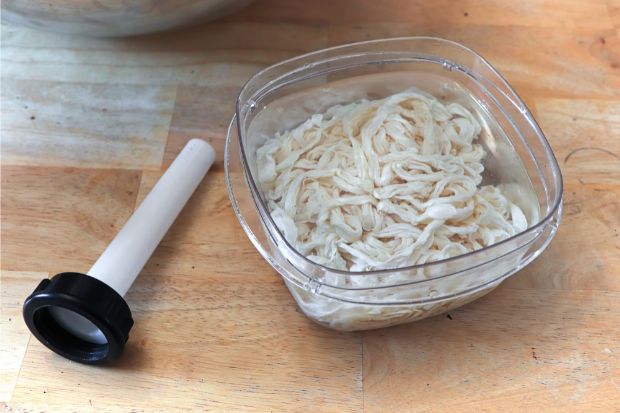Natural sausage casings are made from beef, pork, sheep, and natural collagen. No matter what type you buy, they sometimes become tough in storage or after you cook them.
Sausage casings become tough if you haven’t soaked them and flushed them with water to remove salt. Or they may have been stored for too long. Some chefs say casings should be discarded after six months to one year.
If your sausage casings are tough after cooking, it may be because you didn’t let your sausage meat rise to room temperature after taking it out of the fridge or freezer before cooking or smoking it.
Sausage smoked at temperatures that are too high can develop tough casings, too. Pricking the casing before cooking allows fat and air to get out so there won’t be cracking due to pressure and drying out.

Soaking and Flushing Tough Sausage Casings
When you purchase natural casing, you will notice the casing is preserved with salt. This dries out the casing and can make them tough after cooking. Soaking and rinsing the casings is a crucial step for keeping them tender.
In a large container with lukewarm or warm water, add one tablespoon of vinegar and soak your casing for an hour or a few hours. Vinegar will help tenderize the casing.
After you soak the casing, you should open each one using two fingers and run lukewarm water through it at least twice.

How To Keep Sausage Casings Tender
You can take a few steps to keep sausage casings as tender as possible.
First, do not stuff them or smoke them until your sausage meat reaches room temperature. If the temperature is too cold or hot, this can create a tough sausage casing.
Second, prick the skin with a fork before you cook the sausage. This releases fat and air and keeps them from drying out too much.
How To Store Sausage Casing To Keep It From Getting Tough
The best way to store sausage casings is in an airtight container in the refrigerator. Do not freeze them, as this is known to weaken the casing and can cause them to break. Keep them dry and away from moisture.
When learning to make sausage, many cooks start with beginner’s sausage casings made of natural collagen. Avoid natural collagen made with plastic or wax. Collagen casings have a longer shelf life and need to be kept in a dry, moisture-free area.
Keeping Sausage Casing Tender While Cooking

When you cook your sausage, the casings may become tough. To avoid this, make sure you don’t put your sausages straight into boiling water. Instead, put them in cold water on the stove and bring the temperature of the water to a simmer. Set the temperature to medium-high with enough water to cover your sausages. Cook for about six to eight minutes until the water comes to a simmer. Remove them from the water and slice them or cook them whole in a frying pan, on the grill, or in the oven.
How To Choose the Right Sausage Casing
You should ask your local butcher about sausage casing for making smoked or regular sausage. They can tell you which type is best for the type of sausage you want to make. Beef casings are used to make larger sausages and hard salami. Natural hog casings are used for link sausages for breakfast, Italian sausage, and smoked sausages. Sheep casings are tender but break more easily when cooking.
When you are a beginner, your butcher can recommend a natural collagen casing to start out with. Some cooks buy casings from the butcher soaked in salt brine and recommend these sausage casings.
